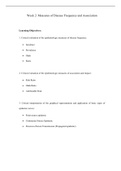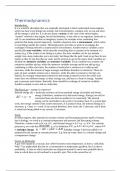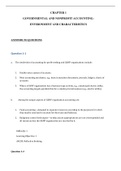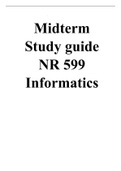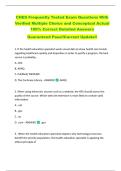Week 2: Measures of Disease Frequency and Association
Learning Objectives:
1. Critical evaluation of the epidemiologic measures of disease frequency:
Incidence
Prevalence
Odds
Rates
2. Critical evaluation of the epidemiologic measures of association and impact:
Risk Ratio
Odds Ratio
Attributable Risk
3. Critical interpretation of the graphical representation and application of basic types of
epidemic curves:
Point source epidemic
Continuous Source Epidemic
Person-to-Person Transmission (Propagated epidemic)
,Contents
Introduction ............................................................................................................................................ 1
Measures of disease frequency .............................................................................................................. 2
Ratio .................................................................................................................................................... 2
Proportion ........................................................................................................................................... 3
Rate ..................................................................................................................................................... 4
Morbidity Frequency Measures .............................................................................................................. 5
Incidence proportion or risk ............................................................................................................... 5
Secondary attack rate ......................................................................................................................... 6
Incidence rate or person-time rate ..................................................................................................... 7
Prevalence......................................................................................................................................... 11
Mortality Frequency Measures ............................................................................................................. 13
Crude death rate ............................................................................................................................... 13
Cause-specific death rate .................................................................................................................. 14
Proportionate mortality .................................................................................................................... 14
Death-to-case ratio ........................................................................................................................... 15
Neonatal mortality rate .................................................................................................................... 16
Post-neonatal mortality rate ............................................................................................................ 16
Infant mortality rate ......................................................................................................................... 17
Maternal mortality rate .................................................................................................................... 18
Standardization ................................................................................................................................. 19
Measures of disease association and impact ....................................................................................... 20
Risk ratio ........................................................................................................................................... 21
Attributable risk ................................................................................................................................ 24
Rate ratio .......................................................................................................................................... 24
Odds ratio ......................................................................................................................................... 25
Types of Epidemic Curves ..................................................................................................................... 27
Point source epidemic ...................................................................................................................... 28
Continuous Source Epidemic ............................................................................................................ 29
Person-to-Person Transmission (Propagated epidemic) .................................................................. 30
References ............................................................................................................................................ 31
,Introduction
A principal task in epidemiology is to quantify the occurrence and distribution of disease or
other health outcome of interest in populations. This is important step that precedes discovering
potential causes of a disease, i.e. identifying association between exposure and outcome, and
consequently determining effective methods for prevention and care (Noordzij et al. 2010).
Therefore, to identify any association between exposure and outcome, at first these two have
to be quantitatively measured. It is done by calculating measures of disease frequency. Once
calculated, the measures of disease frequency are used to calculate measures of association and
impact.
Measuring the disease frequency and association and impact are important to public health
workforce to understand/manage the below:
How large is the disease problem
To compare the amount of disease between groups
To monitor the success of a health promotion/prevention program (Mardones 2018)
There are several measures of disease frequency and measures of association and impact in
common use and - depending on the research question and the available data- one should
choose which measure is appropriate.
This week focuses on the most important measures of disease frequency: incidence, prevalence,
odds and rates, and measures of association and impact: risk ratio, rate ratio, and odds ratio, as
well as formulas for calculating these measures. During this week there will be also introduced
three types of graphic representation of number of outbreak cases by date of disease outbreak
(epidemic curves).
1
, Measures of disease frequency
Commonly used frequency measures are ratios, proportions, and rates. All three frequency
measures have the same basic form:
Numerator
x10n
Denominator
xx
Ratio
Definition of ratio:
A ratio is the relative magnitude of two quantities or a comparison of any two values (Dicker
2006). In simple words, it is a number that is obtained by dividing one number by another. A
ratio doesn't necessarily imply any particular relationship between the numerator and the
denominator.
Method for calculating a ratio:
Number or rate of events, items, persons, etc. in one group
Number or rate of events, items, persons, etc. in another group
After the numerator is divided by the denominator, the result is often expressed as the result
“to one” or written as the result “:1.”
Numerator and denominator can be different categories of the same variable, such as males and
females, so, for example, we may calculate the ratio of women to men in a company. In other
ratios, the numerator and denominator are completely different variables, such as in the
example below.
2
Learning Objectives:
1. Critical evaluation of the epidemiologic measures of disease frequency:
Incidence
Prevalence
Odds
Rates
2. Critical evaluation of the epidemiologic measures of association and impact:
Risk Ratio
Odds Ratio
Attributable Risk
3. Critical interpretation of the graphical representation and application of basic types of
epidemic curves:
Point source epidemic
Continuous Source Epidemic
Person-to-Person Transmission (Propagated epidemic)
,Contents
Introduction ............................................................................................................................................ 1
Measures of disease frequency .............................................................................................................. 2
Ratio .................................................................................................................................................... 2
Proportion ........................................................................................................................................... 3
Rate ..................................................................................................................................................... 4
Morbidity Frequency Measures .............................................................................................................. 5
Incidence proportion or risk ............................................................................................................... 5
Secondary attack rate ......................................................................................................................... 6
Incidence rate or person-time rate ..................................................................................................... 7
Prevalence......................................................................................................................................... 11
Mortality Frequency Measures ............................................................................................................. 13
Crude death rate ............................................................................................................................... 13
Cause-specific death rate .................................................................................................................. 14
Proportionate mortality .................................................................................................................... 14
Death-to-case ratio ........................................................................................................................... 15
Neonatal mortality rate .................................................................................................................... 16
Post-neonatal mortality rate ............................................................................................................ 16
Infant mortality rate ......................................................................................................................... 17
Maternal mortality rate .................................................................................................................... 18
Standardization ................................................................................................................................. 19
Measures of disease association and impact ....................................................................................... 20
Risk ratio ........................................................................................................................................... 21
Attributable risk ................................................................................................................................ 24
Rate ratio .......................................................................................................................................... 24
Odds ratio ......................................................................................................................................... 25
Types of Epidemic Curves ..................................................................................................................... 27
Point source epidemic ...................................................................................................................... 28
Continuous Source Epidemic ............................................................................................................ 29
Person-to-Person Transmission (Propagated epidemic) .................................................................. 30
References ............................................................................................................................................ 31
,Introduction
A principal task in epidemiology is to quantify the occurrence and distribution of disease or
other health outcome of interest in populations. This is important step that precedes discovering
potential causes of a disease, i.e. identifying association between exposure and outcome, and
consequently determining effective methods for prevention and care (Noordzij et al. 2010).
Therefore, to identify any association between exposure and outcome, at first these two have
to be quantitatively measured. It is done by calculating measures of disease frequency. Once
calculated, the measures of disease frequency are used to calculate measures of association and
impact.
Measuring the disease frequency and association and impact are important to public health
workforce to understand/manage the below:
How large is the disease problem
To compare the amount of disease between groups
To monitor the success of a health promotion/prevention program (Mardones 2018)
There are several measures of disease frequency and measures of association and impact in
common use and - depending on the research question and the available data- one should
choose which measure is appropriate.
This week focuses on the most important measures of disease frequency: incidence, prevalence,
odds and rates, and measures of association and impact: risk ratio, rate ratio, and odds ratio, as
well as formulas for calculating these measures. During this week there will be also introduced
three types of graphic representation of number of outbreak cases by date of disease outbreak
(epidemic curves).
1
, Measures of disease frequency
Commonly used frequency measures are ratios, proportions, and rates. All three frequency
measures have the same basic form:
Numerator
x10n
Denominator
xx
Ratio
Definition of ratio:
A ratio is the relative magnitude of two quantities or a comparison of any two values (Dicker
2006). In simple words, it is a number that is obtained by dividing one number by another. A
ratio doesn't necessarily imply any particular relationship between the numerator and the
denominator.
Method for calculating a ratio:
Number or rate of events, items, persons, etc. in one group
Number or rate of events, items, persons, etc. in another group
After the numerator is divided by the denominator, the result is often expressed as the result
“to one” or written as the result “:1.”
Numerator and denominator can be different categories of the same variable, such as males and
females, so, for example, we may calculate the ratio of women to men in a company. In other
ratios, the numerator and denominator are completely different variables, such as in the
example below.
2


